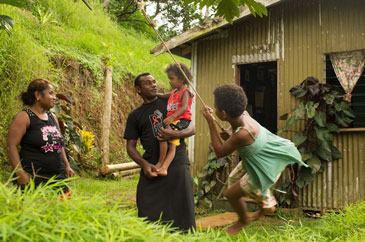The launch of the photography book Our Voyage: Stories of Triumph in the Response to HIV and other STIs in the Pacific on Monday 11 November will mark a number of significant achievements as a result of support from the Pacific Islands HIV and STI Response Fund, a grant funded by the Australian and New Zealand governments and managed by the Secretariat of the Pacific Community (SPC) Public Health Division.
The book will be launched by His Excellency, the President of the Republic of Fiji, Ratu Epeli Nailatikau and blessed by Major Iliesa Cola, Divisional Commander, The Salvation Army, at 6pm on Monday 11 November at the Holiday Inn hotel in Suva.
‘SPC recognises the importance of programming on STIs and sexual health and is consolidating the significant gains made to date as we look to the future, in partnership with Pacific Island Countries and Territories (PICTs). STI prevention and control is a key priority as reflected in the new SPC Public Health Division strategy 2013 - 2022,’ says Dr Colin Tukuitonga, Director of SPC’s Public Health Division.
‘With rates of sexually transmitted infections such as chlamydia as high as 32%, Pacific Island countries and territories (PICTs) are rising to the challenge – successfully implementing targeted prevention and behaviour change communication campaigns, expanding voluntary HIV counselling and testing, strengthening laboratory services and improving chlamydia testing and treatment. PICTs are also collecting data on epidemiological trends to inform evidence-based decision-making and programming,’ says Dr Dennie Iniakwala, HIV and STI Team Leader at SPC.
Nauru and Cook Islands, for example, where chlamydia has been aggressively targeted, have made considerable progress. In 2009, 49% of pregnant women in Nauru had chlamydia. In Cook Islands, it was 20%. By 2012, the proportion of pregnant women with chlamydia in Nauru and Cook Islands had dropped to 4% and 11.5% respectively.
Targeted health communication campaigns are one of eight components of the regional STI control strategy successfully implemented by Cook Islands. Another key component of this strategy was targeted population-based presumptive chlamydia treatment. Such presumptive treatment – whereby infection is presumed in people at high risk of infection whether or not they show symptoms – rapidly reduces the chlamydia rate in targeted groups.
‘Azithromycin was provided to the individuals with water, and they took the tablets on the spot. Booth style clinics were set up around the island so that people could drop in and take their medication,’ explains Cook Islands National HIV STI Coordinator Ana File.
A team of certified counsellors, a doctor and a laboratory technician provided mobile voluntary confidential counselling and testing on the islands of Aitutaki, Pukapuka, Atiu, Mitiaro, Mauke and Mangaia in Cook Islands in an effort to make STI testing more accessible. Over 800 people took advantage of the mobile testing service, including prison inmates.
‘Mobile testing is important because outer islands do not always have access to HIV or STI testing. Making the effort to go to them means we can provide on the spot counselling, testing and treatment and confidentiality is assured,’ explains Ms File.
Success in STI control is just one of ten stories featured in the photography book, commissioned by SPC and the Pacific Response Fund Committee, the body responsible for guiding the management of the grant.
Other highlights include achievements in tackling stigma and discrimination and supporting people living with HIV in the Pacific, national strategic planning, laboratory strengthening, as well as meeting the sexual health needs of vulnerable groups such as men who have sex with men, sex workers, seafarers, and at risk children.
For more information please contact Jacinta Isaacs, Strategic Health Communication Officer, SPC Public Health Division at jacintai@spc.int or Jean-Noel, SPC Assistant Communications Officer, jeannoelr@spc.int.




